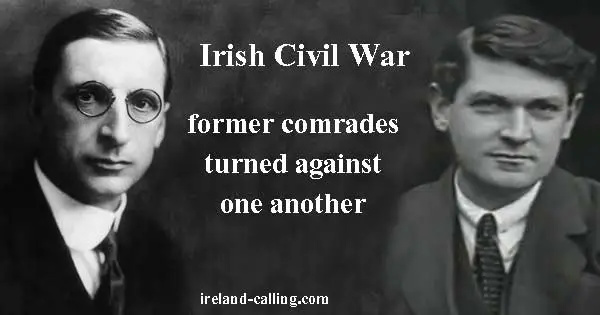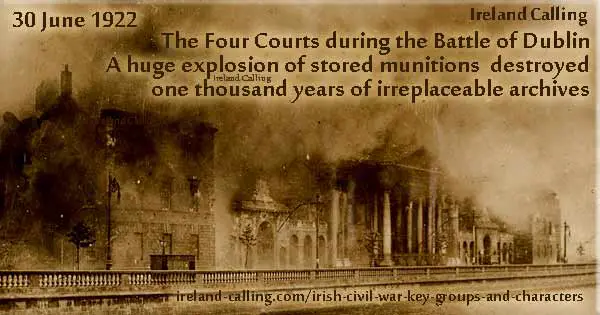The Irish Civil War took place from June 1922 until May 1923. It followed shortly after the signing of the Anglo-Irish Treaty and was fought between the pro-treaty and anti-treaty members of the IRA.civil-war-top.htmlThe Civil War pitted men against each other just months after they had fought alongside each other in the War of Independence. Those that had been fighting to save each other’s lives, were now fighting to kill each other.

The war sums up how desperate the Irish people were to achieve an independent republic, and how sad it is that some believed they had to turn on each other to achieve their aim
Signing of the Anglo-Irish Treaty
The Civil War began officially in June 1922, but the real first action was when Michael Collins and Arthur Griffith signed the Anglo-Irish Treaty in December 1921. The IRA had been fighting in the Irish War of Independence, and the terms of the treaty were not acceptable to some. Ireland had been granted independence, but as a dominion of the British Empire. This meant they still had to swear allegiance to the British Crown, and were not an independent republic.
Michael Collins struggled in the negotiations with the British politicians, who were far more experienced than him. In the end, he had been left with a ‘take it or leave it’ offer and felt that he had no choice but to sign.
He knew his IRA colleagues would not be pleased. He even told his fiancé Kitty Kiernan that in signing the treaty he had ‘signed his own death warrant’. Unfortunately, he was right.
IRA split into two factions
The treaty was taken back to the Dáil and the Irish politicians narrowly voted to accept it. Both the IRA and Sínn Féin were completely split. Éamon de Valera, who had been a close ally of Collins, began touring the country and warning that to achieve an independent republic the Irish would now have to fight their own countrymen.
Collins tried to broker a peace deal to re-unite the IRA, but the terms broke the treaty he had signed with the British and he had to give up after they threatened to take military action.
Collins and the pro-treaty IRA, now known as the Free Staters, began setting up a government to run the country. The anti-treaty IRA re-organised to plan their next move.
Seizure of the Four Courts
The Civil War officially started when a troop of the IRA led by Rory O’Connor seized the Four Courts building in Dublin. The aim was to provoke a military response from Britain, and so re-unite the IRA. The Free State saw it as an act of terrorism against their new regime, and felt they had to deal with it themselves. The British also warned that if the Free State couldn’t keep order in their country, then the governance of it would be taken from them.

A tense stand-off lasted several days. The final straw for Collins was when the IRA kidnapped a soldier of the Free State Army, JJ ‘Ginger’ O’Connell. Collins gave the order for his Free State Army to take back the Four Courts by force. A week of fighting followed that cost several lives on both sides. Cathal Brugha who had been an ally of Collins during the War of Independence was one of the IRA men who died. Rory O’Connor was arrested and imprisoned along with about 500 more. The Free State Army finally gained the upper hand and took control of Dublin.
Anti-treaty were short on weapons
As the war began, the anti-treaty outnumbered the Free State Army by about two to one. However, they lacked a real command structure and were short on weapons. On the other hand, the Irish Free State was able to borrow arms from Britain, and the army was growing at a rapid pace.
The anti-treaty were forced south and west by the Free State Army, who were maintaining control of all the major cities.
Anti-treaty adopt guerrilla warfare tactics used by Collins in War of Independence
civil-war.html”]
